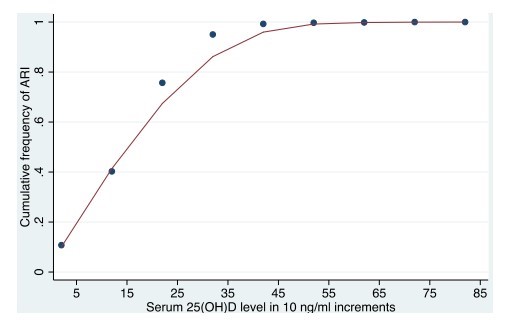Respiratory Infection associated with vitamin D less than 40 ng
Vitamin D Status and Acute Respiratory Infection: Cross Sectional Results from the United States National Health and Nutrition Examination Survey, 2001–2006
Nutrients 2015, 7(3), 1933-1944; doi:10.3390/nu7031933 (registering DOI)
Dominique J. Monlezun 1,2, Edward A. Bittner 3,4, Kenneth B. Christopher 3,5, Carlos A. Camargo Jr. 3,4,6 and Sadeq A. Quraishi 3,4, squraishi@mgh.harvard.edu
1 Tulane School of Public Health & Tropical Medicine, New Orleans, LA 70112, USA
2 Tulane University School of Medicine, New Orleans, LA 70112, USA
3 Harvard Medical School, Boston, MA 02115, USA
4 Massachusetts General Hospital, Boston, MA 02114, USA
5 Brigham and Women’s Hospital, Boston, MA 02115, USA
6 Harvard School of Public Health, Boston, MA 02115, USA

Figure 1. Near linear relationship of acute respiratory infection and 25-hydroxyvitamin D up to 30 ng/mL in LOWESS analysis. Locally weighted scatterplot smoothing analysis = LOWESS 25OHD = 25-hydroxyvitamin D in 10 ng/mL increments; ARI = acute respiratory infection.
Vitamin D is a promising, though under-explored, potential modifiable risk factor for acute respiratory infections (ARIs). We sought to investigate the association of vitamin D status with ARI in a large, nationally-representative sample of non-institutionalized individuals from the United States. We analyzed 14,108 individuals over 16 years of age in the National Health and Nutrition Survey (NHANES) 2001–2006 in this cross-sectional study. We used locally weighted scatterplot smoothing (LOWESS) to depict the relationship between increasing 25-hydroxyvitamin D (25OHD) levels and ARI. We then performed a multivariable regression analysis to investigate the association of 25OHD levels with ARI, while adjusting for known confounders. The median serum 25OHD level was 21 (IQR 15–27) ng/mL. Overall, 4.8% (95% CI: 4.5–5.2) of participants reported an ARI within 30 days before their participation in the national survey. LOWESS analysis revealed a near-linear relationship between vitamin D status and the cumulative frequency of ARI up to 25OHD levels around 30 ng/mL. After adjusting for season, demographic factors, and clinical data, 25OHD levels <30 ng/mL were associated with 58% higher odds of ARI (OR 1.58; 95% CI: 1.07–2.33) compared to levels ≥30 ng/mL. Among the 14,108 participants in NHANES 2001–2006, 25OHD levels were inversely associated with ARI. Carefully designed, randomized, controlled trials are warranted to determine the effect of optimizing vitamin D status on the risk of ARI.
Table 1. Overall sample characteristics and sub-groups with acute respiratory infections


📄 Download the PDF from VitaminDWiki
See also VitaminDWiki
Search "Respiratory Tract Infection" 193 items as of March 2015
Breathing category listing has items along with related searches
Upper respiratory tract infection 2X more likely if vitamin D less than 30 ng – Aug 2013
Vitamin D and Respiratory Tract Infections – meta-analysis with charts June 2013
Acute lower respiratory infection 5X more frequent with low vitamin D intake – June 2012
Fewer respiratory infections if optimal level of vitamin D (more than 47 ng) – Sept 2013
Respiratory infections reduced by 63 percent with 4000 IU vitamin D daily - RCT Dec 2012
Acute respiratory infection treated by vitamin D in 6 of 12 clinical trials – review Nov 2012
100 percent of Acute Respiratory Failure patients had low vitamin D - April 2012
Short url =http://is.gd/RespVitD
